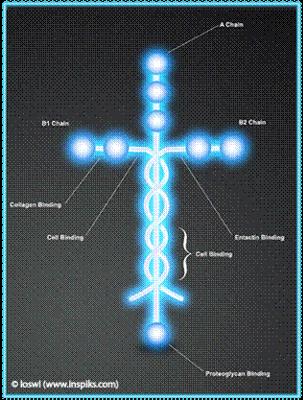 THIS IS LAMININ
THIS IS LAMININGODS DESIGN, ORDER AND CREATION
Have you ever seen laminin before? The above picture is a picture of a laminin. First let me tell you what laminin is. Laminin is a protein found in the "extracellular matrix", the sheets of protein that form the substrate of all internal organs also called the "basement membrane". It has four arms that can bind to four other molecules. The three shorter arms are particularly good at binding to other laminin molecules, which is what makes it so great at forming sheets. The long arm is capable of binding to cells, which helps anchor the actual organs to the membrane. Laminin is extremely important because it makes sure that your overall body structures hold together.
One of the things that I find extremely interesting about laminin is that it is shaped in a cross or crucifix. Laminin can bend its arms and the shape can vary to some degree but for the most part the pictures you will see of laminin will look like a cross.
I believe that this is just another example of how Gods design, creation and order are all linked to his nature. Laminin to me is Gods mark or imprint on his ultimate creation. I find it interesting how the protein is shaped like a cross and the function is to hold us literally altogether. The bible has a verse that actually states something similar in the way that all things are held together by God and all things were created by God. The passage is in Colossians which states 'He is the image of the invisible God, the firstborn over all creation. For by him all things were created; things in heaven and on earth, visible and invisible, whether thrones or powers or rulers or authorities; all things were created by him and for him. He is before all things, and in Him all things HOLD TOGETHER.' (Colossians 1:15-17).
This is just one of many examples. I look at different social institutions such as the family unit with dad, mom and kids, and also the church being God, the leaders and congregation also the trinity with again the number of three being emphasized as the Father, Son, and Holy Spirit. I also look at things in nature such as the bee’s and pollination or the necessity for cockroaches for example as much as I detest them, they to have their place and order in the grand design and scheme of life. Our bodies and all the systems and are intricate design. It is not by chance that we are here and designed the way we are and once you really start to take an in depth look at all of creation, how can anyone deny the existence of God, the creator of all.